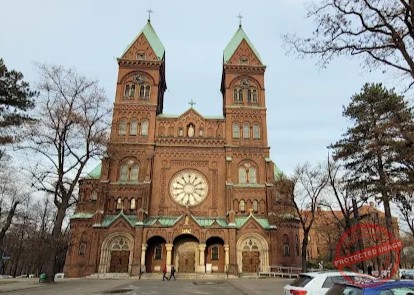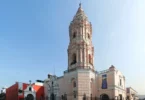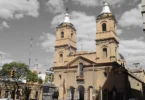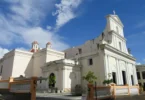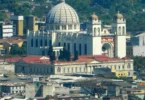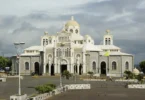Introduction
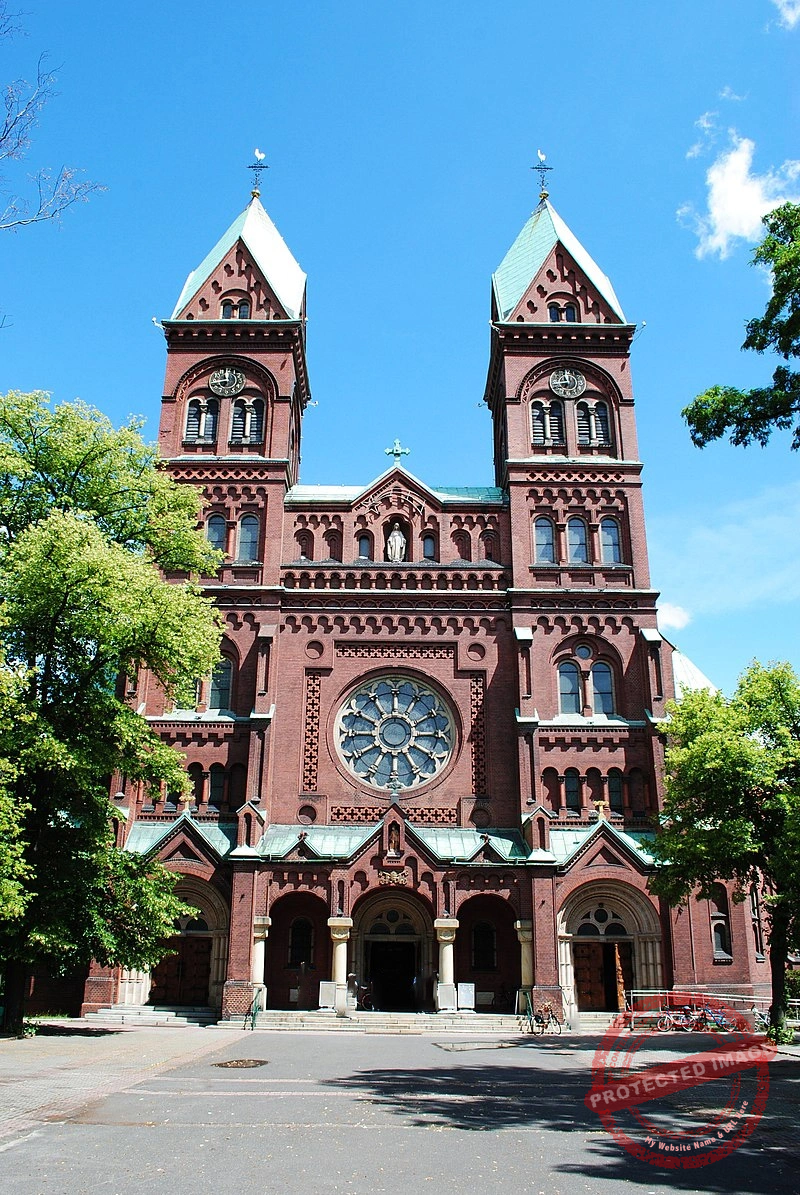
The Basilica of St. Louis the King and the Assumption of the Blessed Virgin Mary is a neo-Romanesque monastery church located in Katowice-Panewniki. Built in the early 20th century, it’s especially well known during the Christmas season, when people from all over come to see its large and beautifully crafted nativity scene. For those who wish to reflect on Christ’s Passion, the church and the nearby Calvary are also significant locations. The Franciscans of the Province of the Assumption of the Blessed Virgin Mary, who are a part of the Order of Friars Minor and run a community in Katowice, use the basilica as their parish church. The Parish of St. Louis the King and the Assumption of the Blessed Virgin Mary in Katowice-Panewniki is part of the Katowice-Panewniki deanery. It was founded on February 12, 1934, and it currently serves approximately 18,500 parishioners.
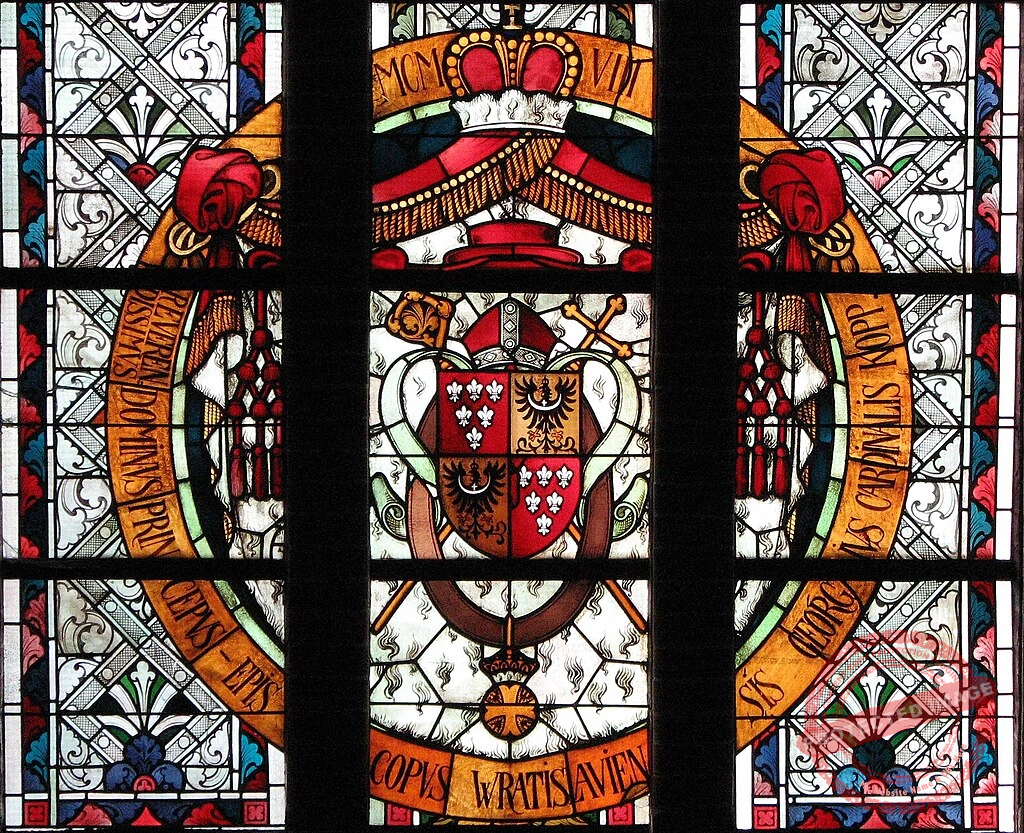
In the 19th century, the Franciscans from Góra Świętej Anny frequently arrived in the industrially and demographically developing eastern fringe of Upper Silesia. Panewniki (today’s district of Katowice), like its neighboring settlements, was then within the German Empire. The decision to permanently settle the Franciscans in Panewniki was based on pastoral considerations the population of both Panewniki and nearby Ligota was growing. The parish church was the church in Mikołów, located 7 km as the crow flies. The land for the construction of the church and monastery in Panewniki was purchased from Johann Kopiniok for 12,500 German marks. The purchase of the 8 hectares on the Kodnica River where the monastery complex and the adjacent Calvary now stand was led by Father Ludwik Skowronek of Bogucice. A down payment of 1,300 marks was made by him. The Wrocław diocesan curia paid the remaining amount from money left for the Franciscan mission by Father Józef Raszek of Lipiny. Cardinal Georg Kopp, the Ordinary of Wrocław , gave permission for the construction of the monastery and the settlement of the monks, as confirmed in a letter addressed to Father Augustyn Schumann, parish priest in Mikołów, dated February 16, 1901. That same year, an additional 1.75 hectares of land was purchased from Franciszek Kempski of Ligota. The Franciscans decided to relinquish ownership of the land to the Wrocław Curia. It was not until 1984, through the efforts of the then-provincial, Father Damian Szojda OFM , that the land on the border of Ligota and Panewniki, where the basilica and convent stand, became the property of the monastic community. The Franciscans, who arrived in Stare Panewniki in 1902, adapted the purchased house at 439 Panewnicka Street for their worship needs . In 1905, a replica of the Lourdes Grotto on the Kodnica River was built, which is now on the grounds of Kalwaria Panewnicka. During the summer, Masses could be held there. Johann Bialetzki of Murcek, a district governor associated with Richard Holtz, a co-founder of Katowice, opposed this religious establishment. Bialetzki’s charges were eventually dropped as a result of a decision made by Count von Heyking, the starost of Pszczyna. After the grotto was completed in 1905, construction of a monastery and church began, designed by Franciscan Brother Mansuetus Fromm, OFM. That same year, permission was received from the authorities in Berlin.
Construction work began on October 4th with a Mass celebrated by the superior of the Custody of St. Jadwiga , Father Krystian Kozubek OFM. Monks from Upper Silesia were included in this administrative unit. Father Ryszard Stehr, the dean of Mokre, laid the church’s cornerstone on July 1, 1906. The work was supervised by Franciszek Neumann from Bytom. Every day before construction began, a short service was held, and Mass was celebrated in the grotto. There were around 200 employees, many of whom were local volunteers. Many women and girls also came to help. Farmers from Panewniki, Piotrowice, Ochojec, and Kostuchna also volunteered to work with their carts . No injuries or occupational accidents were reported during construction. The church and monastery’s outer shell was finished in the spring of 1907, and by the end of the year, the roof had been installed. At the same time, the towers and dome were finished, and the dome was covered with Moselle stone slate. On September 29, 1907, Father Ludwik Skowronek consecrated five new bells for the monastery, and the monks also moved in. The carpentry, joinery, and blacksmithing work was performed by the monks in workshops built adjacent to the monastery. In 1908, stained glass windows, made by the workshop of Victor Anton and Victor Johann Forst in Münster , Westphalia , were installed , and the flooring was laid. The 1.5-ton St. Patrick statue had to be put in place in a month and a half. Francis of Assisi on the dome.
The entire monastery complex was built at a cost of 1,166,215 marks, which did not include the unpaid labor of the population or the material contributions of donors (wood, sand, stone, and other materials). Among the most distinguished donors, monastery chronicles list: Lazarus IV Henkel von Donnersmarck of the Bytom-Siemianowice line and his wife Maria von Schweinitz; Francis II Xaver Graf von Ballester of Pławniowice and his wife Jadwiga von Sauerma-Jeltsch; and the married couple Count Hans Ulrich von Schaffgotsch of Kopice near Grodków and Joanna Schaffgotsch. The church was consecrated on July 19, 1908, by Cardinal Georg Kopp. The ceremony attracted 80,000 faithful. Over 50 special trains were dispatched to the station in Ligota. Members of the Prussian Parliament from Upper Silesia arrived in Panewniki that day. In the initial period of the Franciscans’ activity in Panewniki, they faced harsh press attacks: the German press accused the monks of being a hotbed of Polishness, while the Polish press accused them of Germanization. Services and masses were celebrated in Latin, and attacks targeted sermons preached in both Polish and German. The main altar of the church was completed in July 1909. The Stations of the Cross were consecrated on February 13, 1910. The church was intended to be equipped with electric lighting, but this became possible only in the interwar years. After the Second Vatican Council, the chancel was rebuilt, following the principles of liturgical reform. Since November 12, 1974, Pope Paul VI gave the church the status of minor basilica. Since 1908 (or 1913) a nativity scene has been built in the basilica, which is currently the largest altar nativity scene in Europe.
Architecture of Basilica of St. Louis and the Assumption of the Blessed Virgin Mary, Katowice-Panewniki, Poland
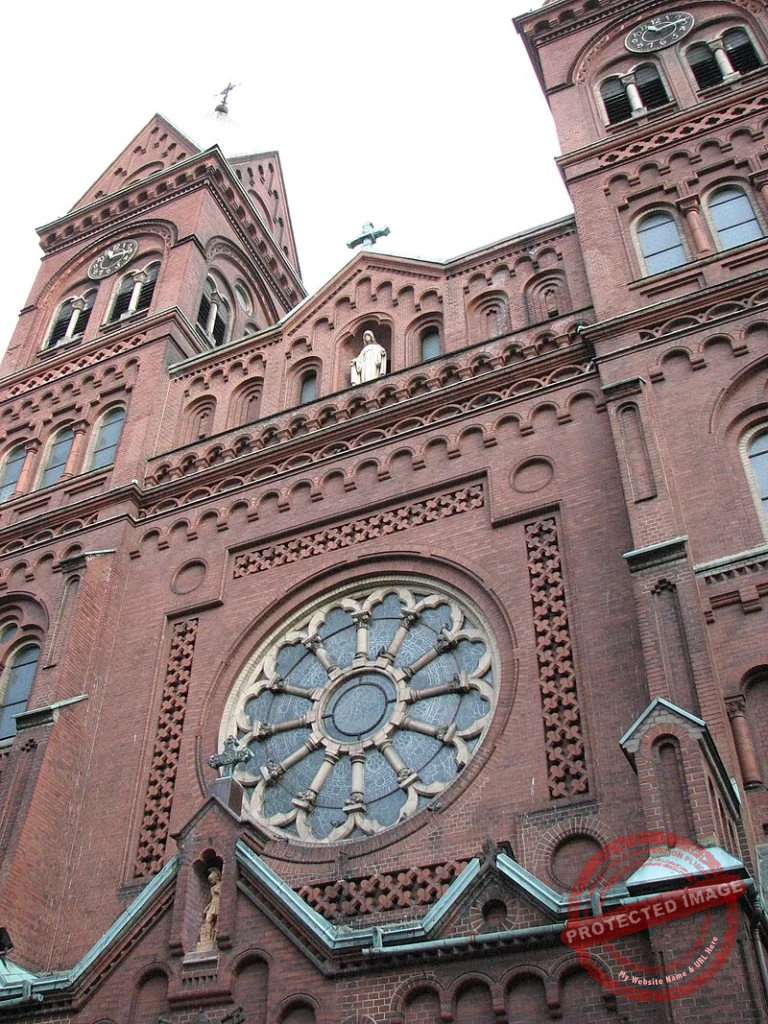
Architectural style: Romanesque Revival architecture
The basilica’s structure, like the entire monastery complex, is Romanesque in style. The church is not oriented the chancel faces north with a 27-degree inclination to the east. The exterior walls of the building are constructed of rough-textured clinker brick. Stone sculptures like portals, portico columns, and bifora window columns were part of Brother Fromm’s original design. Brick shapes form arcade friezes and cornices in various places. The central nave, transept, and chancel are covered with gable roofs with dormers. The chancel apse and the side apses are covered with semi-conical roofs. The main dome is covered by an eight-slope tented roof with dormers. The naves and the eastern ambulatory are covered with lean-to roofs. The porches and cloisters are covered with gable roofs. Systems of four rhomboid planes falling diagonally form the roofs of the towers in the front of the basilica. The façade is 28 meters high. Its lower section features a tripartite portico. Its vault is supported by sandstone columns. The portico is decorated with a frieze of arcaded blind windows. A statue of St. Florian occupies a niche in the main arcade. The side doors to the basilica, located beneath the towers in the façade, are decorated with arcaded portals. In the central part of the façade is a stained-glass rosette with a diameter of 7 meters, bordered on all four sides by a frieze of ceramic shapes with a quatrefoil motif. In the corners, circular blind windows are located. A statue of the Virgin Mary is placed at the top of the façade, with a cross above it . On the façade’s sides, six-story, 48-meter-tall towers rise. The top stories are sharply truncated and covered with roofs. In 1913, clocks were installed in the towers. The roofs of the Panewniki basilica are covered with copper sheeting.
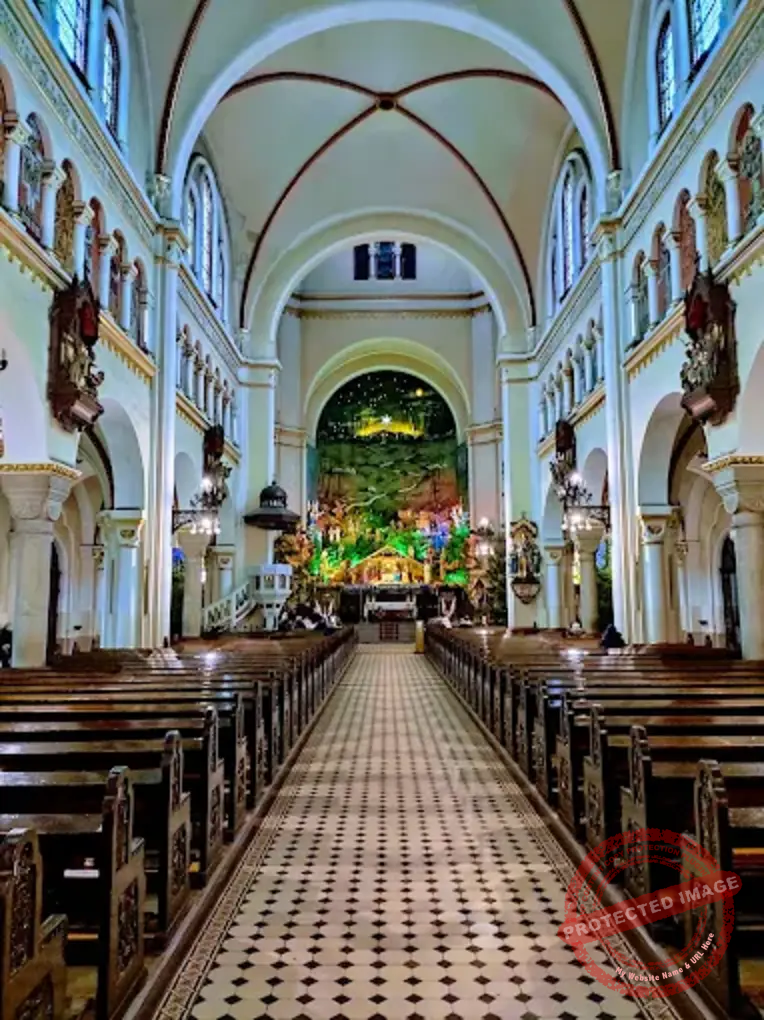
Interior of the temple
The basilica’s interior consists of a tripartite nave, a transept, and a two-part chancel. The basilica is 76 meters long and 22.5 meters wide. The side aisles are 7 meters wide and the central nave is 17.5 meters high. The ribbed vault rests on a system of pillars and columns. Heads of angels adorn the pillar capitals. In the gallery of arcade blinds on both sides of the central nave, paintings by Norbert Paprotny that depict scenes from St. In 1963, Francis of Assisi was installed. Stations of the Cross created by German companies in Trier and Gladbach can be found in the central nave and transept. To the left of the central nave is the pulpit, and to the right is a sculpture depicting St. Louis the King – the first patron saint of the Panewniki church.
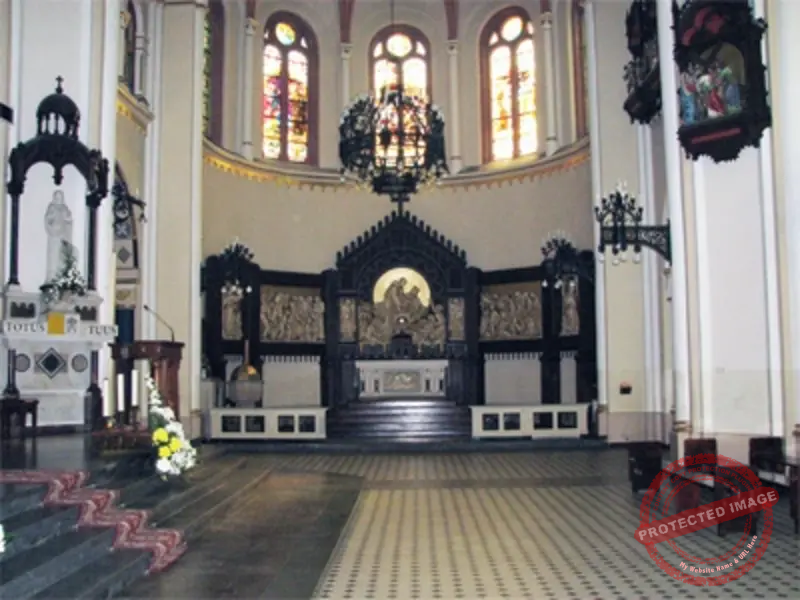
Altars
The interior of the basilica in Panewniki is full of altars, and there’s a reason for that. Every priest individually celebrated Mass prior to the Second Vatican Council’s liturgical reforms, typically in the early morning hours. The church needed several altars as a result. A few to more than a dozen Franciscan friars lived in the convent that served the basilica at the time. Today, there are about eighty, including around thirty priests. One of the most striking is the Altar of St. Barbara, which can be found in the left side aisle at the back. The sculpture shows St. Barbara of Nicomedia protecting miners. In the year 1920, the altarpiece was made in Bavaria. The Altar of The transept’s left apse is where St. Francis of Assisi is seated. It’s made up of five beautifully detailed ivory-colored bas-reliefs, created in 1920 by sculptor Georg Schreiner from Regensburg. The altar was funded by the Szklorz family from Wełnowiec. Towering above it are 4.6-meter-high stained glass windows showing scenes from the life of the saint. Over on the right transept, you’ll find the Altar of St. Anthony of Padua. The order for this one was placed in 1919, but it wasn’t delivered to Panewniki until 1927. Also made by Georg Schreiner, it was funded by the Lapski family from Bytom. It shows key moments from the life of St. Anthony, surrounded by high stained glass windows that add a splash of color to the setting. At the rear of the right side aisle is the Altar of Our Lady of Sorrows, a powerful depiction of the Pieta. It was donated by the Brotherhood of Christian Mothers of Panewniki and was made in 1920 by Bruno Tschötschel, who was from Wrocaw.
Chapels
The basilica also features several chapels, each with its own story and spiritual focus. The Former Chapel of the Blessed Sacrament is located just to the left of the main entrance, in the porch of the left tower. It was consecrated on September 10, 1988, by Father Damian Szojda OFM. Daily adoration used to take place here. The sheet metal and grating were designed by Eryk Złotoś from Ligota, and there’s a painting of Our Lady of the Gate of Dawn. Plaques honoring monks who perished in concentration camps, victims of violence perpetrated by the Soviet Union and Stalinism, and members of underground resistance groups who were executed between 1945 and 1956 are displayed on the wall. The chapel was closed after 24-hour adoration began in the Fatima chapel. Along the extended left side of the nave is where you will find the Chapel of Saints Romanos and Ptolemy of Nepi. The Sacred Heart of Jesus altar used to be in this location, but in 1914, a new one was built in Wrocaw. A dolomite ciborium and a reliquary are included on the altar. There was even an attempted theft of the reliquary in 1970. The chapel features polychrome paintings: one of St. Maximilian Kolbe (added in 1987), and one showing the martyrdom of Saints Romanos and Ptolemy, painted by Roman Pająk and restored by Jan Gałaszek in 1988. On the opposite side, in the extended right side nave, you’ll find the Chapel of Our Lady of Częstochowa. The altar here was made in Koblenz and consecrated in 1910, thanks to funding from the Bogucice parish. A copy of the Black Madonna painting was donated by the Szklorz family. Otto Kowalewski’s polychrome painting of St. Francis asking for the indulgence of the Porziuncola. These murals were restored twice, most recently in 1988. Lastly, there’s the Chapel of Our Lady of Fatima, created in 1988 after the eastern wing of the basilica was rebuilt. It features a 1960 Fatima-brought sculpture. Since the start of perpetual adoration, this chapel has been open 24 hours a day and serves as the church’s main adoration chapel.
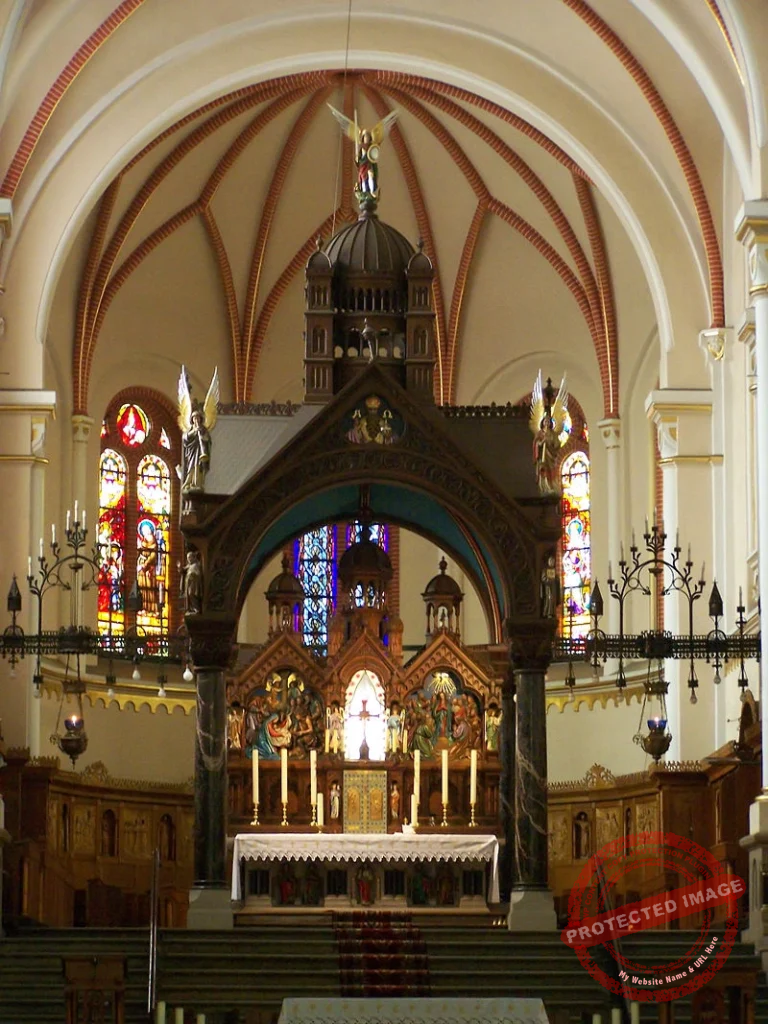
Presbytery
The chancel, an extension of the main nave, is divided into two sections: the lower section with the main altar, where Masses are currently celebrated, and the upper section, containing the old altar with a tabernacle and canopy. In the lower section of the chancel are wall-mounted chapels dedicated to the Sacred Heart of Jesus and the Immaculate Heart of the Virgin Mary . The upper section houses the monastic choir with stalls. Scenes from Paul’s life made of wood are used as decorations in the choir. St. Francis and figures of saints and blessed. The richly carved retable is made of oak. The altar in the upper chancel was consecrated in 1908 and was founded by the Third Franciscan Order.
Crypt
In the crypt, beneath the upper part of the chancel and monastic choir, lies the Chapel of St. Joseph. Doors lead to the chapel from the basilica, from the monastery gate, from the parish office in the monastery basement, and from the outside on the western side. Its groin vault rests on ten pillars. The crypt is 18 meters long. The altar, depicting the transit of St. Joseph, was created in 1908. The foundation was created by the Rogosz family from Nowy Browiniec . The stained glass windows in the crypt depict scenes from the life of St. Joseph. The crypt contains a number of confessionals . The sacrament of penance is administered in the Chapel of St. Joseph.
Organs
The agreement for the construction of the organ between the monastery and the Berschdorf company from Nysa was signed in 1922. Its consecration was performed by the administrator, Father August Hlond, on April 13, 1925. The reconstruction was carried out by the following companies: Berschdorf in 1944, Franke from Rybnik (1962–1965), and Biernacki from Warsaw (1987–1988). After 2003, the instrument was cared for by the organ builders Mirosław Klonowski and Jan Wyleżoł.
Organists
After the church in Panewnik was opened, monks served as organists. The composer Father Ansgary Malina also played the organ and accompanied liturgical singing. From 1956 to 1986, the organist at the basilica was Wiktor Pinkawa. Born in Gogolin on October 7, 1917. He began playing at Mass after meeting Father Ansgary Malina at the Franciscan college in Kobylin. From 1928, he lived with his family in Ligota. During World War II, his leg was amputated. He graduated from the State Higher School of Music in Katowice. He worked first as a music teacher at the 7th General Secondary School in Ligota, then at the Szafranek School in Rybnik . He was an accompanist for the St.Gregory Choir in Panewnik. He composed and arranged choral works, including the song for choir “Niepokalana”. He died on June 5, 2007 in Katowice. He is buried in the municipal cemetery in Ligota. Zygmunt Pinkawa has been the organist since 1986. Born on September 8, 1944, in Katowice. A graduate of the Szafranek School in Rybnik and the Faculty of Music Education in Cieszyn. In the years 1970–2002 he taught in primary schools in Katowice. In the years 1982–1984 he was the conductor of the Katowice Men’s Choir “Hejnał”. Lecturer at the Franciscan Major Seminary in Katowice. Accompanist of the St. Gregory Choir at the Basilica of Panewniki.
Bells
In the towers of the basilica hang five bells, each with its own story, tone, and history. The smallest of them, cast in 1938, came from the Karol Schwabe Bell Foundry in Biała and weighs about 260 kg. It’s named Adam-Jan-Stanisław. The next three bells St. Joseph, St. Anthony, and St. Francis were cast in the 1960s in the foundry of Fathers Drożdż and Kubica in Dąbrowa Górnicza. They vary in size, with St. Francis weighing around 1,700 kg and measuring 140 cm in diameter. But the largest and most impressive is the jubilee bell, dedicated to Mary Assumed into Heaven and St. Louis the King. Cast in 2008 in the Rudolf Perner Bell Foundry in Passau, it weighs over 2 tons and has a diameter of 151 cm. It’s deep, solemn sound echoes far beyond the basilica walls. There’s also a sixth bell smaller and more modest hidden in the bell turret above the chancel. Altogether, these bells form not just a part of the building’s structure, but of its soul. They ring out across Sejny on holidays, in times of joy, mourning, and prayer, as they’ve done for decades.
Feast Day
Feast Day : August 15 – Assumption of the Blessed Virgin Mary
August 25 – St. Louis
The main feast day of the Basilica of St. Louis the King and the Assumption of the Blessed Virgin Mary in Katowice-Panewniki is celebrated on August 15th, the Feast of the Assumption of the Blessed Virgin Mary. Additionally, the basilica observes the Feast of St. Louis the King on August 25th. Both feasts are significant for the parish community. They are marked by special liturgies and celebrations.
Church Mass Timing
Monday to Saturday : 6:00 AM, 6:45 AM, 7:30 AM, 8:00 AM, 9:00 AM, 12:00 PM, 6:30 PM.
Sunday : 5:30 AM, 6:30 AM, 8:00 AM, 9:30 AM, 11:00 AM, 12:30 PM, 2:00 PM, 4:30 PM, 6:30 PM, 8:00 PM.
Church Opening Time:
Monday to Friday : 6:00 AM, 7:00 PM.
Saturday, Sunday : 5:30 AM, 8:00 PM.
Contact Info
Address : Basilica of St. Louis and the Assumption of the Blessed Virgin Mary
Panewnicka 76, 40-760 Katowice, Poland
Phone : +48 32 252 68 70
Accommodations
Connectivities
Airway
Basilica of St. Louis and the Assumption of the Blessed Virgin Mary, Katowice-Panewniki, Poland, to Katowice International Airport, distance between 54 min (52.8 km) via S1.
Railway
Basilica of St. Louis and the Assumption of the Blessed Virgin Mary, Katowice-Panewniki, Poland, to Katowice Główne (Main Station), distance between 16 min (5.9 km) via Ligocka and Mikołowska.a

